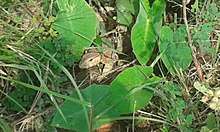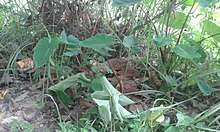Yellow monitor
| Yellow (golden) monitor lizard | |
|---|---|
 | |
| Scientific classification | |
| Kingdom: | Animalia |
| Phylum: | Chordata |
| Class: | Reptilia |
| Order: | Squamata |
| Family: | Varanidae |
| Genus: | Varanus |
| Subgenus: | Empagusia |
| Species: | V. flavescens |
| Binomial name | |
| Varanus flavescens (Hardwicke & Gray, 1827) | |

The yellow monitor or golden monitor, Varanus flavescens, is a species of monitor lizard found in Asia. It is also called Sun Gohoro (in Nepali).[2] It is also known as SANGOIH (सनगोहि) in Maithili.
Description
Varanus flavescens has subcorneal teeth, scarcely compressed. Its snout is short and convex, measuring a little less than the distance from the anterior border of the orbit to the anterior border of the ear; canthus rostralis distinct. Its nostril an oblique slit, a little nearer to the end of the snout than to the orbit. Digits short, the length of the fourth toe, measured from its articulation with the tarsus to the base of the claw, not exceeding the length of the femur. The tail of the yellow monitor feebly compressed, keeled above. Scales of head small, subequal; the median series of supraocular scales slightly dilated transversely. Scales on upper surfaces moderate, oval, keeled. Abdominal scales smooth, in 65 to 75 transverse rows. Caudal scales keeled; the caudal keel with a very low, doubly toothed crest. Olive or yellowish brown above, with irregular darker markings which are generally confluent into broad cross bars; a blackish temporal streak; lower surfaces yellowish, with rather indistinct brown cross bars, which are most distinct on the throat. Young dark brown above, with yellow spots confluent into crossbars; lower surface yellow, with dark brown cross bars.[3]

Population
The actual population or population trends is unknown. However, it is considered that the species has low population density even in its preferred habitat. Limited studies suggest that the species is decreasing, however more studies required to confirm actual trend of the species.[4][5][6]
Habitat and ecology
The species prefers wet areas, found to be edge of forest and near to human settlements that increase its threat from direct killing. It looks like V. flavescens tolerate the habitat modification of some degree for agriculture as it was also found on agricultural land. They are not habitat specialist group, but generally less found on forest with large trees, dry areas. It is a carnivorous lizard, and less adapted to climb on trees due to its short hind toes.[7] They separate the habitat with sympatric V. bengalensis, as former prefers wet areas with high ground cover and later prefers the areas with large trees.[8][9]
A medium-sized monitor, it measures from snout to vent 448 mm; 952 mm including the tail and weight up to 1450 gm.[10]
Distribution
Flood plains of the Indus, Ganges and Brahmaputra rivers in India, Pakistan, Nepal and Bangladesh.[11]
Threat
Previously international trade was a major threat to the species, but the current status of the trade is unknown. However, the local and national trade creates a threat to the species (in Nepal).[12] Direct killing is the major threat to the species. Lack of knowledge about the species among local people is the cause of most of the killing, most of the killing is related to use and trade of the skin. Ignorance is a root issue, no campaign to spread awareness or education of the local people is being conducted.[13] Creation of Protected areas is insufficient for the species as most of potential habitat lies outside the protected areas and it is often found near to human settlement; this increases the threat to the species.[14]
Conservation
The yellow monitor Varanus flavescens is protected in all range countries except Bhutan; Nepal, India, Pakistan and Bangladesh.[15] As data is inadequate for the species, research for its distribution, population status, trend, ecology and threats are urgent.[16] The countries should enforce the legal measure to stop the local trade and killing of the species. As there is low awareness among people about its importance and legal status, they should be made aware about it.[17]
Notes
- ↑ World Conservation Monitoring Centre (1996). "Varanus flavescens". The IUCN Red List of Threatened Species. IUCN. 1996: e.T22872A9396496. doi:10.2305/IUCN.UK.1996.RLTS.T22872A9396496.en. Retrieved 10 November 2017.
- ↑ Ghimire, H. R.; Phuyal, S.; Shah, K. B. (2014). "Protected species outside the protected areas: People's attitude, threats and conservation of the Yellow Monitor (Varanus flavescens) in the Far-western Lowlands of Nepal". Journal for Nature Conservation. 22 (6): 497–503. doi:10.1016/j.jnc.2014.08.003.
- ↑ Boulenger, G. A. 1890. Fauna of British India. Reptilia and Batrachia.
- ↑ Ghimire, H. R. (2012). Distribution and Conservation Status of Yellow Monitor, Varanus flavescens (Hardwicke and Gray, 1827) in Parasan VDC of Kanchanpur District, M.Sc. thesis, Central Department of Environmental Science, Tribhuvan University, Nepal. doi:10.13140/RG.2.1.2180.5605
- ↑ Ghimire, H. R.; Phuyal, S.; Shah, K. B. (2014). "Protected species outside the protected areas: People's attitude, threats and conservation of the Yellow Monitor (Varanus flavescens) in the Far-western Lowlands of Nepal". Journal for Nature Conservation. 22 (6): 497–503. doi:10.1016/j.jnc.2014.08.003.
- ↑ Ghimire, H. R.; Shah, K. B. (2014). "Status and habitat ecology of the Yellow Monitor, Varanus flavescens, in the Southeastern part of Kanchanpur District, Nepal" (PDF). Herpetological Conservation and Biology. 9 (2): 387–393.
- ↑ Ghimire, H. R.; Shah, K. B. (2014). "Status and habitat ecology of the Yellow Monitor, Varanus flavescens, in the Southeastern part of Kanchanpur District, Nepal" (PDF). Herpetological Conservation and Biology. 9 (2): 387–393.
- ↑ Ghimire, H. R.; Phuyal, S.; Shah, K. B. (2014). "Protected species outside the protected areas: People's attitude, threats and conservation of the Yellow Monitor (Varanus flavescens) in the Far-western Lowlands of Nepal". Journal for Nature Conservation. 22 (6): 497–503. doi:10.1016/j.jnc.2014.08.003.
- ↑ Ghimire, H. R.; Shah, K. B. (2014). "Status and habitat ecology of the Yellow Monitor, Varanus flavescens, in the Southeastern part of Kanchanpur District, Nepal" (PDF). Herpetological Conservation and Biology. 9 (2): 387–393.
- ↑ Ghimire, H. R.; Shah, K. B. (2014). "Status and habitat ecology of the Yellow Monitor, Varanus flavescens, in the Southeastern part of Kanchanpur District, Nepal" (PDF). Herpetological Conservation and Biology. 9 (2): 387–393.
- ↑ Monitor-lizards.net
- ↑ Ghimire, H. R.; Phuyal, S.; Shah, K. B. (2014). "Protected species outside the protected areas: People's attitude, threats and conservation of the Yellow Monitor (Varanus flavescens) in the Far-western Lowlands of Nepal". Journal for Nature Conservation. 22 (6): 497–503. doi:10.1016/j.jnc.2014.08.003.
- ↑ Ghimire, H. R.; Phuyal, S.; Shah, K. B. (2014). "Protected species outside the protected areas: People's attitude, threats and conservation of the Yellow Monitor (Varanus flavescens) in the Far-western Lowlands of Nepal". Journal for Nature Conservation. 22 (6): 497–503. doi:10.1016/j.jnc.2014.08.003.
- ↑ Ghimire, H. R.; Phuyal, S.; Shah, K. B. (2014). "Protected species outside the protected areas: People's attitude, threats and conservation of the Yellow Monitor (Varanus flavescens) in the Far-western Lowlands of Nepal". Journal for Nature Conservation. 22 (6): 497–503. doi:10.1016/j.jnc.2014.08.003.
- ↑ Ghimire, H. R.; Shah, K. B. (2014). "Status and habitat ecology of the Yellow Monitor, Varanus flavescens, in the Southeastern part of Kanchanpur District, Nepal" (PDF). Herpetological Conservation and Biology. 9 (2): 387–393.
- ↑ Ghimire, H. R.; Phuyal, S.; Shah, K. B. (2014). "Protected species outside the protected areas: People's attitude, threats and conservation of the Yellow Monitor (Varanus flavescens) in the Far-western Lowlands of Nepal". Journal for Nature Conservation. 22 (6): 497–503. doi:10.1016/j.jnc.2014.08.003.
- ↑ Ghimire, H. R.; Phuyal, S.; Shah, K. B. (2014). "Protected species outside the protected areas: People's attitude, threats and conservation of the Yellow Monitor (Varanus flavescens) in the Far-western Lowlands of Nepal". Journal for Nature Conservation. 22 (6): 497–503. doi:10.1016/j.jnc.2014.08.003.
References
- Auffenberg W. Rahman H. Iffat F. Perveen Z. 1989 A STUDY OF VARANUS-FLAVESCENS HARDWICKE AND Gray (SAURIA VARANIDAE). J. Bombay Nat. Hist. Soc. 86 (3): 286-307 [1990]
- Ghimire, H. R. (2012). Distribution and Conservation Status of Yellow Monitor, Varanus flavescens (Hardwicke and Gray, 1827) in Parasan VDC of Kanchanpur District, M.Sc. thesis, Central Department of Environmental Science, Tribhuvan University, Nepal. doi:10.13140/RG.2.1.2180.5605
- Ghimire, H. R.; Phuyal, S.; Shah, K. B. (2014). "Protected species outside the protected areas: People's attitude, threats and conservation of the Yellow Monitor (Varanus flavescens) in the Far-western Lowlands of Nepal". Journal for Nature Conservation. 22 (6): 497–503. doi:10.1016/j.jnc.2014.08.003.
- Ghimire, H. R.; Shah, K. B. (2014). "Status and habitat ecology of the Yellow Monitor, Varanus flavescens, in the Southeastern part of Kanchanpur District, Nepal" (PDF). Herpetological Conservation and Biology. 9 (2): 387–393.
- Visser, G. J. (1985). "Notizen zur Brutbiologie des Gelbwarans Varanus (Empagusia) flavescens (HARDWICKE & Gray 1827) im Zoo Rotterdam". Salamandra. 21 (2/3): 161–168.
- Whitaker, Rom 1981 Bangladesh - Monitors and turtles Hamadryad 6 (3): 7-9
